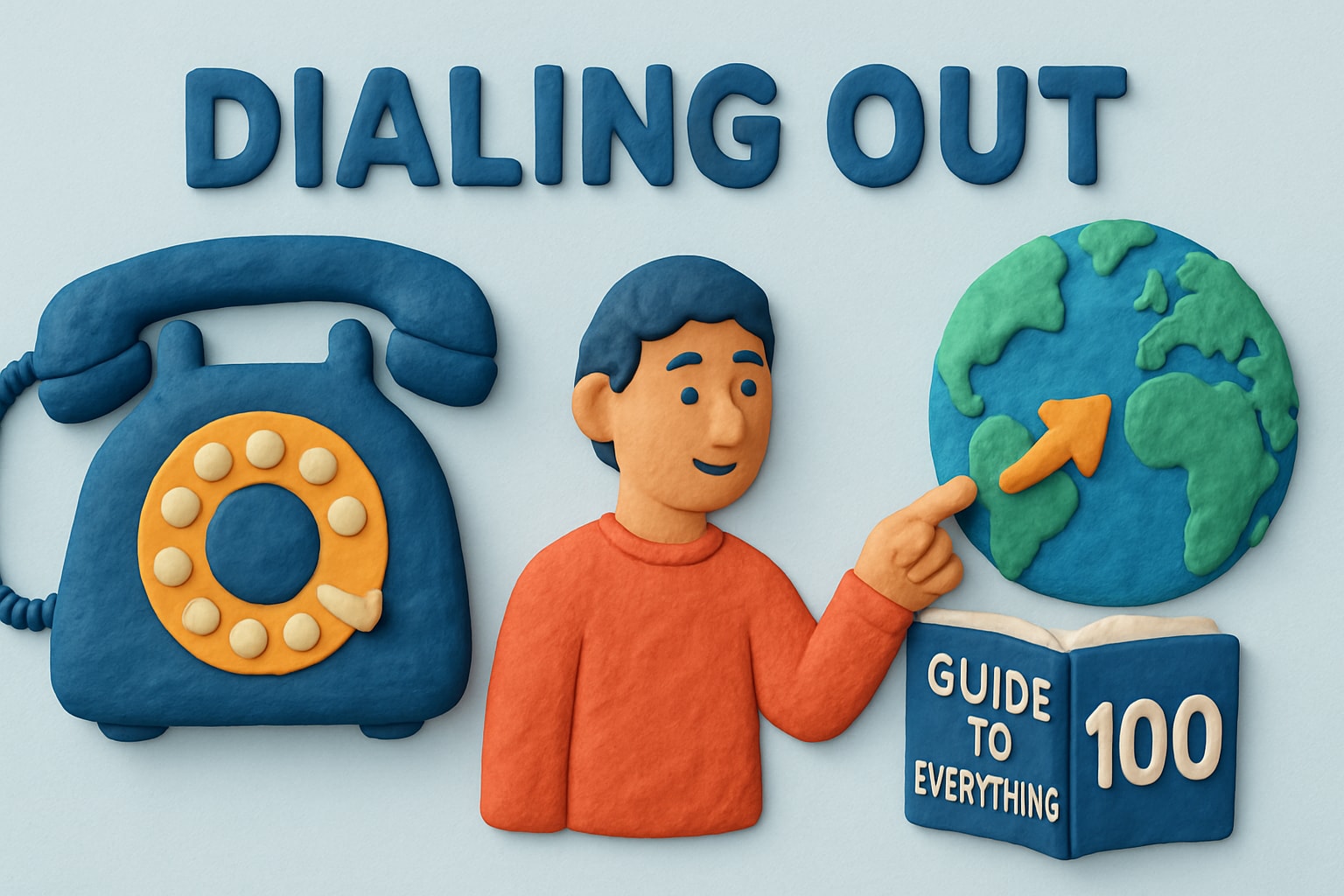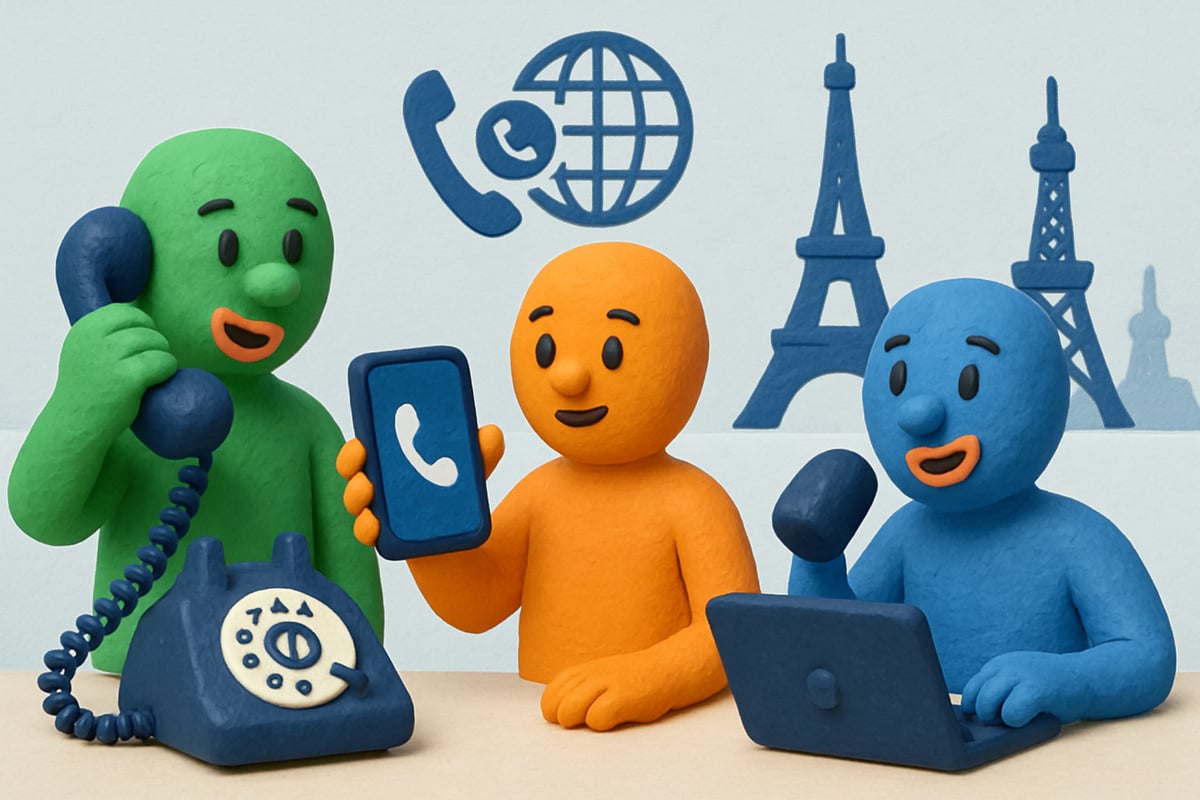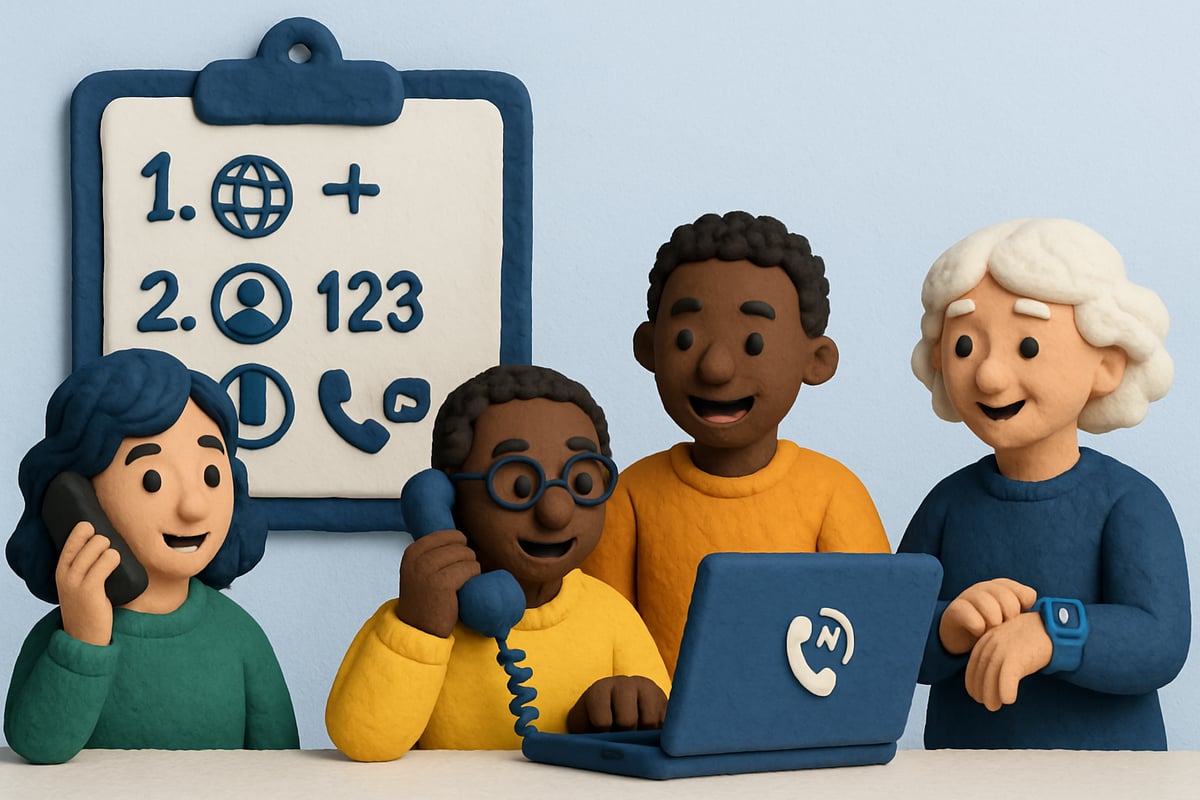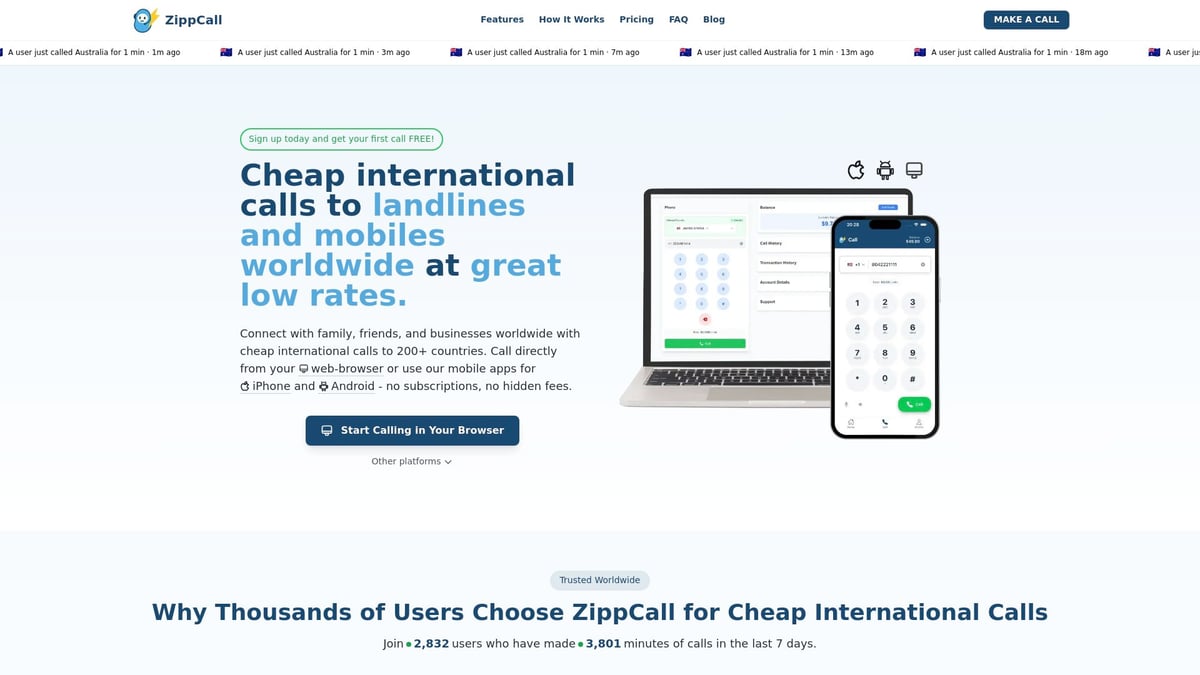
In 2025, staying connected across borders is more important than ever. Whether you are calling loved ones, handling business, or traveling, reliable communication is key.
This guide will help you understand every aspect of dialing out, so you can reach anyone, anywhere, with confidence. We will break down the basics, share updated codes, walk you through step-by-step instructions, and explore the latest technology trends.
Along the way, you will learn how to save money, avoid common mistakes, and solve dialing problems quickly. Ready to simplify your connections? Let us get started together.
Understanding Dialing Out: The Basics in 2025
Staying connected across borders is easier than ever, but the process of dialing out can still feel confusing if you’re not familiar with the latest changes. Whether you’re calling for business, travel, or just to hear a loved one’s voice, understanding the basics of dialing out in 2025 is a must. Let’s break it down together so you can call confidently, wherever you are.

What Does "Dialing Out" Mean?
Dialing out means placing a call to someone outside your current phone network. This could involve reaching a different office, city, or even country.
Unlike internal calls, which stay within a company or local area, dialing out connects you to external numbers. This is relevant for everyone, from mobile and VoIP users to those on traditional landlines. Knowing when you’re dialing out helps you choose the right codes and avoid surprises.
Key Components: Country Codes, Exit Codes, and Area Codes
To successfully complete a dialing out call, you need to understand three types of codes: country codes, exit codes, and area codes.
Country codes identify the country you’re calling. In 2025, some countries have updated their codes, so it’s important to double-check before dialing. Exit codes are used to signal you’re calling out of your country, and these vary by region (for example, the US uses 011, while the UK uses 00). Area codes help route your call to the correct city or region within a country.
For the latest list of country codes and updates, check out the International dialing country codes page. Having these codes handy ensures your dialing out experience is smooth and frustration-free.
Types of Dialing Out: Domestic vs. International
Dialing out domestically is different from making an international call. When you dial within your own country, you typically use an area code and the local number.
International dialing out, however, requires an exit code, the destination country code, and often an area code before the local number. For example, calling from the US to Europe means a different sequence than calling a neighbor. Regulatory rules and number formats can also vary, so it’s smart to check before you dial.
Devices and Platforms for Dialing Out
You can dial out from a variety of devices: landlines, mobile phones, computers, or even smart speakers.
App-based and browser-based calling platforms are growing rapidly, letting users make calls over the internet instead of traditional phone lines. In fact, industry reports show VoIP and app usage for dialing out is surging, making communication more accessible and affordable for everyone.
Common Challenges in 2025
Even with new technology, dialing out can still present a few hurdles. Navigating updated number formats or regulations can be tricky.
Sometimes, numbers are blocked or restricted, making it hard to reach certain destinations. Call quality can vary depending on your network or device. Being aware of these challenges helps you solve problems quickly and stay connected.
Example Scenarios
Let’s look at a few real-life situations where dialing out is essential. Maybe you’re calling family overseas to catch up, or you need to connect with business partners in another country.
You might even need to dial out for emergency assistance while traveling. Each scenario highlights the importance of understanding how dialing out works in 2025.
Step-by-Step Guide: How to Dial Out in 2025
Ready to make a call across town or across the globe? Let’s walk through a simple, step-by-step process so you can master dialing out in 2025. Whether you’re reaching out to friends, family, or business contacts, these easy steps will help you connect smoothly every time.

Step 1: Identify the Type of Call (Domestic or International)
Before you start dialing out, figure out whether your call is domestic or international. Domestic calls use local or national codes, while international calls require country and exit codes. This distinction matters because it determines the sequence of numbers you’ll need. For example, calling your neighbor is different from calling someone abroad. Always check if your number is local or if you’re reaching across borders for effective dialing out.
Step 2: Gather Required Codes and Numbers
To begin dialing out, collect all the necessary information. You’ll need the correct country code, exit code, and area code for your destination. In 2025, updated online lookup tools make this easy. For example, if you’re calling London from the US, you’ll need the UK’s country code (44) and the US exit code (011). Double-check codes to avoid misdials during dialing out.
Step 3: Choose Your Device or Platform
Next, pick the device or platform that suits your needs. You can use a landline, mobile phone, or a digital platform like VoIP or a web-based calling app. Each has its benefits: landlines offer stability, mobiles provide convenience, and VoIP apps are often cost-effective. Curious about making international calls online? Check out this helpful How to make international calls online guide for tips on modern dialing options.
Step 4: Enter the Dialing Sequence Correctly
Now it’s time to enter the dialing sequence. Here’s a typical example for dialing out from the US to Germany:
| Step | Example (US to Germany) |
|---|---|
| Exit Code | 011 |
| Country Code | 49 |
| Area Code | 30 (for Berlin) |
| Local Number | 12345678 |
So, you’d dial: 011 49 30 12345678
Avoid common mistakes, like missing a code or entering the wrong sequence, to make sure dialing out is successful.
Step 5: Confirm Connection and Call Quality
Once you’ve dialed, listen for the ringing tone or connection message. If the call doesn’t go through, check for error messages or busy signals. For best results, ensure your device has a stable network or internet connection. If you hear echoes, static, or dropped calls, try switching networks, moving to a quieter spot, or restarting your app or device. These steps help ensure clear, reliable communication.
Step 6: Manage Costs and Call Duration
Be mindful of how long you’re dialing out, especially for international calls. Use built-in timers or apps to track your call duration and expenses. Many platforms offer dashboards to monitor your spending in real time, helping you stay within budget. Managing your dialing out costs ensures you avoid surprise fees and get the most value for your money.
Step 7: Record Important Numbers and Codes for Future Use
Finally, save frequently dialed numbers and codes for quick access next time. Use your phone’s contact list, a secure notes app, or a password manager for added security. Storing this information makes dialing out faster and reduces the chance of errors. Regularly update your lists so you’re always ready to connect with loved ones or colleagues, no matter where they are.
Latest Technologies Shaping Dialing Out
Staying connected across the globe has never been easier, thanks to rapid advances in technology. In 2025, dialing out is more intuitive and accessible than ever before, allowing us to reach friends, family, and colleagues no matter where we are. Let’s explore the latest tools and trends redefining how we connect.

Rise of VoIP and App-Based Calling
VoIP (Voice over Internet Protocol) has taken center stage in the world of dialing out. Instead of relying on traditional phone lines, most calls now travel over the internet, making international dialing out more affordable and flexible. Popular apps let us make calls directly from browsers or mobile devices.
Recent data shows that VoIP adoption is growing rapidly, with billions of minutes logged each month. For a detailed look at this trend, see Global VoIP Market Growth Projections. As a result, dialing out is no longer limited by borders or expensive carrier rates, opening up new possibilities for everyone.
Integration with Smart Devices and Virtual Assistants
Dialing out has evolved beyond phones and computers. Smart speakers, watches, and even in-car systems now make it possible to place calls with just a voice command. Imagine asking your virtual assistant to connect you to a loved one overseas, hands-free.
These smart devices help streamline dialing out by syncing contacts, remembering frequently dialed numbers, and even suggesting the best times to call. This seamless integration makes staying in touch feel almost magical.
Enhanced Security and Privacy Features
In 2025, dialing out is safer than ever thanks to end-to-end encryption and advanced authentication. Modern platforms ensure that your conversations remain private, protecting sensitive information from eavesdroppers.
New regulations also require providers to strengthen privacy standards. As we continue dialing out, these features offer peace of mind, so we can focus on what matters most: meaningful conversations.
AI and Automation in Dialing
Artificial intelligence is reshaping how we approach dialing out. AI-powered contact managers can organize and update your address book, while auto-dialers simplify calling large groups or scheduling reminders.
Businesses benefit from predictive dialing, which increases efficiency and connects teams faster. For everyday users, AI means less hassle and more time spent connecting with others through dialing out.
Improved Call Quality: HD Voice and 5G
Crystal-clear audio is now the norm when dialing out, thanks to HD voice technology and widespread 5G networks. These advances reduce lag and background noise, making international conversations feel as natural as local ones.
With 5G, even video calls and group chats are smooth and reliable. This leap in quality ensures that dialing out delivers a rich, lifelike experience every time.
Example Use Cases
Let’s see how these advancements play out in real life. Remote teams use smart apps for conference calls, making dialing out a breeze. Families separated by continents rely on secure, high-quality video chats to stay close.
Whether you’re managing business connections or sharing a moment with loved ones, dialing out in 2025 is designed to bring us all closer together.
Cost Management and Saving Strategies for Dialing Out
Managing the cost of dialing out in 2025 is easier than ever, thanks to new tools, transparent pricing, and better competition. Whether you call internationally for work, study, or to reach loved ones, understanding how charges are calculated is the first step to saving money.
Understanding International Calling Rates in 2025
International dialing out rates can vary widely, depending on your provider and the countries you call. Rates are typically set per minute, per second, or as flat fees for certain destinations. Traditional carriers may still charge higher rates, while digital platforms are known for their competitive pricing.
Here is a quick comparison:
| Provider Type | Avg. Rate (per min) | Billing Method | Flexibility |
|---|---|---|---|
| Traditional Carrier | $0.50 | Per Minute | Low |
| VoIP/App-Based | $0.05 | Per Second | High |
Knowing these differences helps you make informed decisions before you start dialing out.
Tips for Reducing Dialing Costs
To lower your dialing out expenses, consider using calling cards, bundled minutes, or taking advantage of off-peak rates. Many services now let you make calls over Wi-Fi or data, which can drastically reduce costs—especially for frequent international connections.
Try these strategies:
- Use free or low-cost app-based calling.
- Schedule calls during off-peak times.
- Look for special international bundles from reputable providers.
By mixing these tips, you can keep your dialing out budget in check without sacrificing connection quality.
Choosing the Right Provider
Selecting the best provider for dialing out is all about transparency, reliability, and support. Compare rates, check for hidden fees, and read customer reviews. Use online tools that let you compare providers side by side, so you know exactly what you are getting.
Key factors to consider:
- Clear pricing with no surprises
- Responsive customer support
- Consistent call quality
With the right provider, dialing out becomes less stressful and more affordable for everyone.
ZippCall: Affordable, Simple International Calling
If you want a straightforward solution for dialing out internationally, Affordable international calling with ZippCall stands out. ZippCall uses a pay-as-you-go model with global coverage, making it ideal for personal and business use.

There are no contracts, subscriptions, or hidden fees. Users often save up to 90% compared to traditional carriers. Plus, you can access ZippCall from your browser or mobile app, giving you full flexibility for dialing out anywhere, anytime.
Monitoring and Managing Call Expenses
Keeping track of your dialing out costs is simple with today’s apps and dashboards. Many providers offer tools that let you set budget limits and receive alerts when you approach them.
Take advantage of these features to avoid surprises and maintain control. This way, dialing out never puts a strain on your finances.
Real-World Example: Saving on Frequent International Calls
Consider an expat or remote worker who dials out to family overseas every week. By switching from a traditional carrier to a digital platform, they can save hundreds of dollars monthly.
Students studying abroad and global teams also benefit from these savings. Making smart choices about dialing out providers and monitoring tools ensures your money is spent wisely.
Troubleshooting Common Dialing Out Issues
Staying connected is essential, but even in 2025, dialing out can sometimes hit a snag. Let’s explore the most common issues and how to resolve them, so you can keep your conversations flowing smoothly.
Connection Failures and Error Codes
Sometimes, dialing out just doesn't work and you’re met with mysterious error codes or failed connections. This usually happens when an exit code, country code, or area code is entered incorrectly, or if the number is blocked. Network outages or temporary restrictions can also cause problems.
Here’s a quick reference table for common error messages:
| Error Code | Meaning | Quick Fix |
|---|---|---|
| 403 | Forbidden/Blocked Number | Check number, unblock |
| 404 | Number Not Found | Verify number entered |
| 488 | Not Acceptable Here | Try different network |
Double-check every step of the dialing out process to avoid these errors.
Audio Quality and Dropped Calls
Frustrated by choppy audio or calls that drop unexpectedly? These issues often stem from poor internet connections, low signal strength, or device compatibility problems. With more people using VoIP and app-based solutions, network quality matters more than ever. According to VoIP Adoption and Usage Trends, maintaining a stable connection is key to clear calls.
If you experience issues, try switching to Wi-Fi, updating your calling app, or moving to a spot with better coverage. For persistent problems, contact your service provider.
Billing and Unexpected Charges
Surprised by a bigger bill than expected? This can happen if you’re unaware of the current rates or if you accidentally connect to premium numbers. Always check your provider’s rates before dialing out, especially for international calls or special services.
If you spot an unfamiliar charge, review your call logs and reach out to customer support to dispute it. Setting up spending alerts can help prevent future surprises.
Regulatory and Number Blocking Issues
In 2025, new telecom regulations may impact dialing out, especially across borders. Some countries now restrict specific numbers or require updated formats, which can lead to blocked or failed calls. If your call isn’t going through, confirm the latest dialing requirements for your destination.
Using the correct sequence and staying updated with regulatory changes helps ensure your dialing out experience stays hassle-free.
Support and Resources
When troubleshooting dialing out issues, you’re not alone. Most providers offer online support centers, live chat, and step-by-step guides. Community forums and FAQs can also offer quick fixes from people who’ve faced similar issues.
For the most complex problems, don’t hesitate to contact your provider’s technical support. Staying proactive ensures your connection remains reliable, wherever you are.
Future Trends in Dialing Out: What to Expect Beyond 2025
Staying ahead in the world of dialing out means understanding the exciting changes just over the horizon. Let’s look at what’s coming next, so you can keep connecting without missing a beat.
Emerging Technologies and Protocols
The future of dialing out is being shaped by innovative technologies. Next-gen communication protocols are emerging, making calls faster and more reliable. Integration with AR and VR platforms is on the rise, promising new, immersive ways to connect. For a deeper dive into these trends, check out VoIP Industry Statistics and Future Trends for insights on where the industry is headed.
Regulatory Shifts and Numbering Updates
Telecom regulations are always evolving, especially for dialing out. Expect global dialing codes and number formats to change as countries adapt to new security and privacy standards. Keeping up-to-date with these changes will be crucial to avoid interruptions in your calls and ensure compliance with the latest rules.
The Role of 5G and Beyond
5G networks are transforming dialing out, bringing ultra-fast speeds and crystal-clear call quality. With lower latency and better coverage, international calls will sound more like local ones. As these networks expand, dialing out will become smoother, more accessible, and reliable for everyone, everywhere.
The Evolution of User Behavior
People are shifting how they approach dialing out. There’s a growing preference for app-based communication and integrated services, as shown in VoIP Market Size and Adoption Rates. Pay-as-you-go and on-demand options are gaining popularity, making global calling easier and more affordable than ever.
Preparing for the Future
Ready for what’s next in dialing out? Stay informed about new technologies, code updates, and user trends. Bookmark reputable resources, sign up for provider alerts, and join online communities. By keeping learning, you’ll always be prepared to connect with anyone, anywhere, no matter how dialing out evolves.
Now that you’ve got the inside scoop on dialing out in 2025—from updated country codes to smart new calling tools—it’s time to put that knowledge to work. We all want to stay close to friends, family, and colleagues around the world without worrying about confusing fees or complicated apps. With ZippCall, you can jump right in and make international calls easily from your browser, no downloads or subscriptions needed. Let’s keep those important connections strong and stress free. Ready to reach out wherever you are?
Start Calling
Ready to Try ZippCall?
Make affordable international calls on web, iPhone, and Android devices. Crystal-clear quality with competitive rates.
1 minute setup. No subscription required.